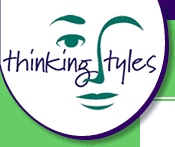 |
| |
| The Thinking Styles profile identifies 26 ways of thinking.
These are called "dimensions" by psychologists. Each of these
can be identified in the language we use and the behaviours
we adopt. |
| |
| Each dimension has: |
| • |
Specific linguistics or associated language patterns |
| • |
Associated behaviours known as 'surface traits' which
are visible to others |
|
| |
| Thinking Styles measures: |
| |
| • |
Four Sensory Focused dimensions, exploring the
ways you prefer to receive information via your senses |
| |
| • |
Eight People Focused dimensions, exploring the
ways you interact with people |
| |
|
| • |
Fourteen Task Focused dimensions, exploring the
ways you relate to tasks and activities at work |
|
| |
Dimension Explanations
Here are the behavioural examples which relate to each type
of thinking. |
| |
|
Sensory Focused:
Explores the ways you prefer to receive information via your
senses.
| Visual thinking: |
the use of pictures, diagrams and visual imagery internally
and externally. |
| Auditory thinking: |
a focus on the use of words and language, listening
and talking things through. |
| Kinaesthetic thinking: |
the use of feelings, emotions, intuition and physical
exercise. |
| Digital thinking: |
involves a focus on the facts, and/or the use of data
and statistics. |
|
| |
|
People Focused:
Explores the way you interact with people.
| Internal thinking: |
relies on their own judgments & standards, believes
oneself to be right, ignores feedback. |
| External thinking: |
relies on feedback from others, believes that others
are right. |
| |
| Self referenced thinking: |
puts their own needs first and ignores the needs of
other people. |
| Altruistic thinking: |
responsive to the needs of others and willing to help
other people. |
| |
| Conformist thinking: |
wants to fit in, dislikes confrontation and takes a
non-challenging approach. |
| Challenging thinking: |
dislikes being told what to do, will challenge and confront. |
| |
| Collaborative thinking: |
involves others, shares information, prefers a team
environment. |
| Competitive thinking: |
wants to win and better ones'
own performance. |
|
 |
Task Focused:
Explores the way you relate to tasks and activities at work
and your approach to problem solving.
| Strategic thinking: |
focuses on general principles & summary information
often in terms of key points. |
| Detail Conscious thinking: |
believes details are important & attends to detailed
information. |
| |
| Creative thinking: |
creative, naturally multi-tasks, has an untidy workspace,
works backwards. |
| Logical thinking: |
processes systematically in sequence, ordered, completes
1 task at a time. |
| |
| Options thinking: |
explores opportunity & possibility, seeks choice and
alternatives, adds to work. |
| Procedural thinking: |
procedures are important, follows instructions & the
correct way of doing things. |
| |
| Towards thinking: |
focuses on goals & targets, says what they want and
has a positive attitude. |
| Troubleshooting thinking: |
focuses on problems, makes contingency plans, may worry. |
| |
| Proactive thinking: |
initiates action, gets on with things, proactive approach. |
| Reactive thinking: |
waits, analyses and plans, reviews all the relevant
info and considers consequences. |
| |
| Simplicity filter: |
often simplifies complex issues and prefers things to
be easy. |
| Complexity filter: |
enjoys the challenge of difficulty and of complex issues. |
| |
| Sameness thinking: |
seeks stability and the familiar; prefers gradual change,
notices similarities. |
| Differences thinking: |
notices what is different; seeks variety, has a high
capacity & tolerance for change. |
|
| |
|
If you would like to see the questionnaire - click
here.
If you would like to develop flexibility in some of these
styles of thinking - click
here.

|
| |
|
|
|


